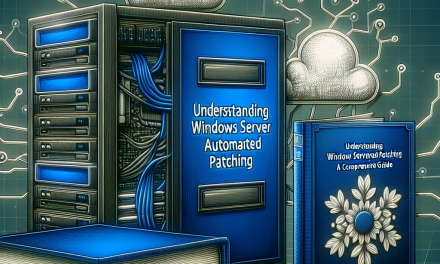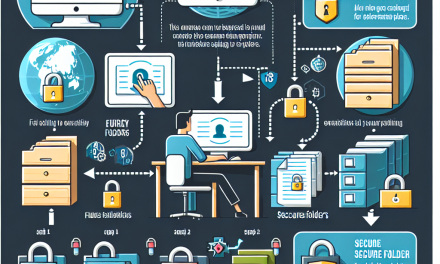As organizations increasingly rely on digital data to drive their operations, the importance of securing that data cannot be overstated. Windows Server offers various encryption options to protect sensitive information stored on file shares. This article delves into Windows Server encryption for file shares, providing insights into the types of encryption available, how to implement them, and best practices to secure your data effectively.
What is Windows Server Encryption?
Windows Server encryption refers to the methods and technologies used to protect data stored on Windows Server file shares from unauthorized access. This security layer ensures that even if the physical storage medium is compromised, the data remains inaccessible without proper authorization. Two primary encryption methods are prevalent in Windows Server environments: Encrypting File System (EFS) and BitLocker.
1. Encrypting File System (EFS)
EFS is a built-in encryption feature in Windows Server that allows users to encrypt individual files and folders. This method is integrated into the NTFS file system and provides a user-friendly approach to securing sensitive data.
How EFS Works
When a user encrypts a file or folder using EFS, Windows generates a unique encryption key known as a File Encryption Key (FEK). This key encrypts the file content and is, in turn, encrypted with the user’s Public Key (part of their certificate stored in the Certificate Store). Only the user who encrypted the file can access the decrypted content, provided they have their private key.
Advantages of EFS
- User Control: Users can encrypt files and folders easily without requiring administrative privileges.
- Transparent Operations: Once files are encrypted, users can access them in the same manner as unencrypted files, making it seamless.
- Flexible: EFS can be applied to individual files or entire folders, allowing for granular control of what is encrypted.
Limitations of EFS
- Backup and Recovery: If a user loses their certificate or private key, access to encrypted files may be permanently lost unless a recovery agent is configured.
- Not Suitable for All Files: EFS does not encrypt file names, creating potential vulnerabilities.
- Complexity in Multi-User Environments: Sharing encrypted files with other users can complicate access management.
2. BitLocker Drive Encryption
BitLocker is a full-disk encryption feature that secures an entire volume in Windows Server. Unlike EFS, which focuses on individual files and folders, BitLocker protects data at the disk level, ensuring that all files on the encrypted volume are safeguarded.
How BitLocker Works
When BitLocker is enabled on a volume, it uses a combination of the Trusted Platform Module (TPM), user credentials, and/or a startup key to encrypt the entire storage device. This means that unauthorized users cannot access the data stored on the drive unless they possess the necessary authentication details.
Advantages of BitLocker
- Comprehensive Security: Protects all data on the drive, including system files, cookies, and temporary files.
- Pre-Boot Authentication: Enhances security by requiring authentication before the operating system loads.
- Easy Management: BitLocker can be centrally managed via Group Policy or Microsoft Endpoint Manager, allowing IT administrators to enforce encryption policies organization-wide.
Limitations of BitLocker
- Performance Overhead: On older systems, users may experience performance impacts while accessing encrypted drives.
- Lost Recovery Keys: If not properly managed, lost recovery keys can lock out users from accessing critical data.
- Not File-Level: It does not provide the same granularity as EFS for encrypting individual files or folders.
Implementing Encryption in Windows Server
Encrypting Files and Folders with EFS
- Select the File/Folder: Right-click on the file or folder you want to encrypt.
- Choose Properties: Click on "Properties" from the context menu.
- Advanced Options: Click the "Advanced" button.
- Encrypt: Check the box “Encrypt contents to secure data” and click OK.
- Apply Changes: Choose whether to encrypt the file only or the entire folder.
Enabling BitLocker on a Volume
- Open Server Manager: Navigate to Server Manager on your Windows Server.
- Select the Volume: Right-click on the volume you want to encrypt and select "Turn On BitLocker."
- Choose Authentication Method: Decide how you want to unlock the drive (TPM, password, USB key).
- Backup Recovery Key: Store the recovery key safely.
- Encrypt the Volume: Begin the encryption process and wait for it to complete.
Best Practices for Windows Server Encryption
- Implement a Data Loss Prevention (DLP) Strategy: Ensure that you have a robust DLP strategy alongside encryption to manage sensitive information effectively.
- Regularly Backup Encryption Keys: Keep backup copies of encryption keys and certificates in a secure location to avoid data loss.
- Educate Users: Train users on the importance of encryption, including EFS usage and safe handling of private keys.
- Regular Audits: Conduct audits to review encryption policies and ensure compliance with organizational standards.
- Monitor for Unauthorized Access: Implement logging and monitoring to track unauthorized attempts to access encrypted data.
Conclusion
Windows Server encryption for file shares, through technologies like EFS and BitLocker, provides effective mechanisms to secure sensitive data against unauthorized access. By understanding the features, advantages, and limitations of these encryption methods, organizations can make informed decisions to protect their information assets. Implementing best practices and educating users will further enhance the security posture of your Windows Server environment, ensuring that your data remains confidential and secure.
For more tech insights and tips, stay tuned to WafaTech Blogs!





